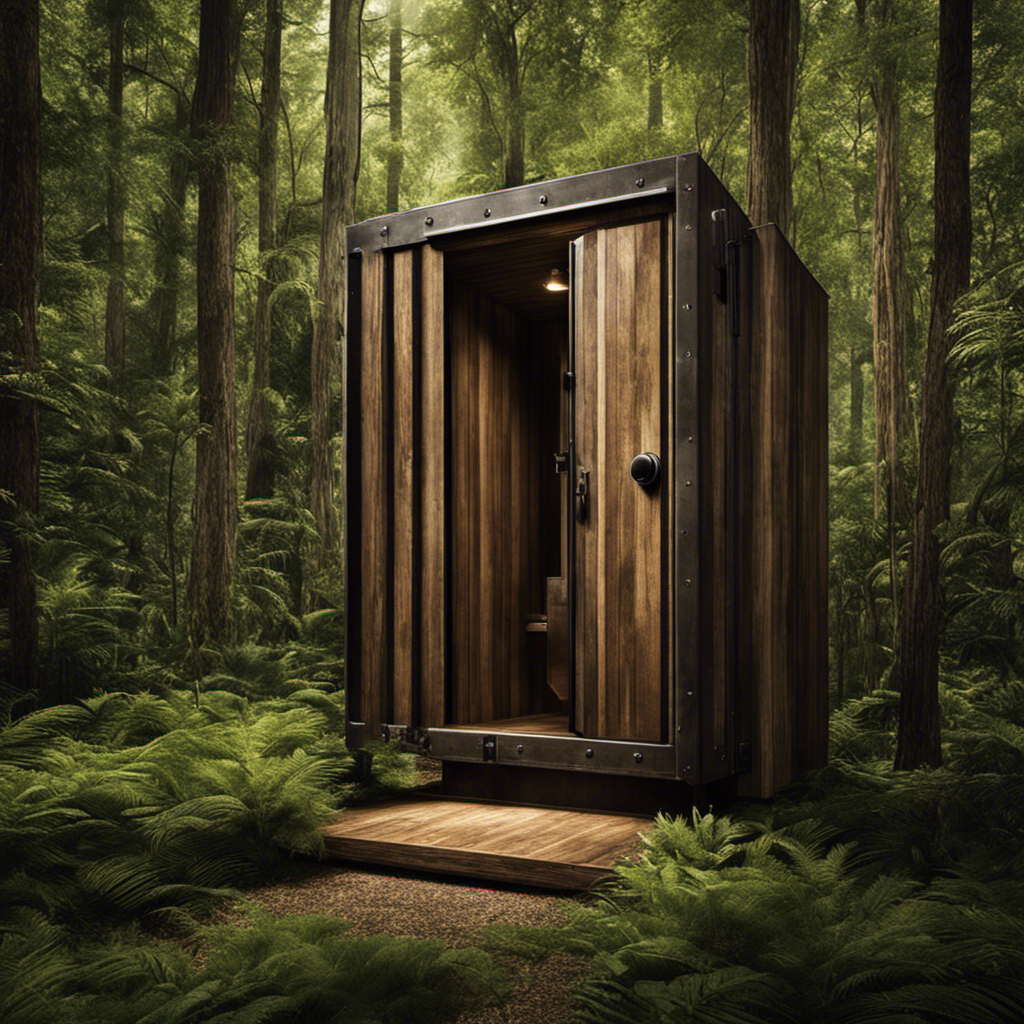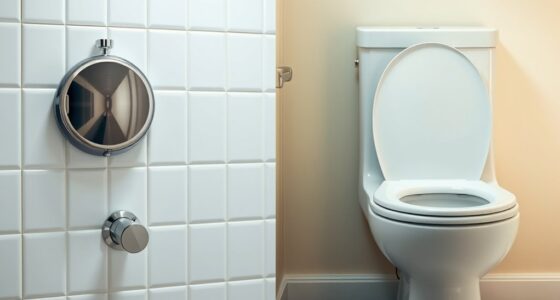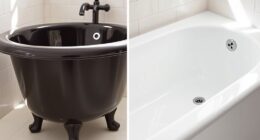As a homeowner, I’ve always been conscious of my impact on the environment. That’s why I decided to explore the world of composting toilets. These innovative systems offer an eco-friendly alternative to traditional flush toilets, reducing water consumption and waste.
In this article, we’ll dive into the world of composting toilets, discovering how they work, the different types available, and the maintenance required.
So, if you’re interested in minimizing your ecological footprint, join me on this journey to understand the wonders of composting toilets.
Key Takeaways
- Composting toilets reduce water consumption and help conserve water resources.
- They are suitable for off-grid locations and can be used to promote sustainable agriculture.
- Composting toilets utilize natural processes to break down waste and transform it into nutrient-rich compost.
- Different types of composting toilets are available, each with their own advantages and disadvantages.
Benefits of Using a Composting Toilet
There are several benefits of using a composting toilet. One benefit is the reduction in water consumption. Composting toilet technology is designed to break down human waste naturally. It does this by using a combination of aerobic bacteria, heat, and moisture. By diverting waste away from traditional sewage systems, composting toilets help conserve water. This is because they do not require flushing. This can be especially useful in areas with limited water resources or in off-grid locations.
Another benefit of composting toilets is the creation of nutrient-rich compost for plants. The compost produced by these toilets can be used as a valuable fertilizer. It enriches the soil with essential nutrients. This can help plants grow healthier and stronger.
However, it is important to note that composting toilet regulations vary across different jurisdictions. Therefore, it is crucial to ensure compliance with local laws and regulations when installing and using a composting toilet.
How Does a Composting Toilet Work
To understand how a composting toilet works, it’s important to know that it utilizes natural processes to break down waste. The design of a composting toilet is crucial in ensuring the efficient decomposition of organic material.
Typically, these toilets consist of a separate compartment for solid waste and a chamber for urine. The solid waste compartment is layered with organic materials such as sawdust or coconut coir, which help absorb moisture and promote aerobic decomposition.
The materials used in a composting toilet are carefully chosen to maintain the right balance of carbon and nitrogen, essential for the breakdown of waste. The decomposition process is facilitated by microorganisms, such as bacteria and fungi, which thrive in the warm and oxygen-rich environment of the toilet.
Over time, the waste is transformed into compost, a nutrient-rich material that can be safely used as fertilizer for plants.
Types of Composting Toilets
When considering the different types of composting toilets, it’s important to weigh the pros and cons of each option.
Some potential benefits include:
- Reduction of water usage
- Production of nutrient-rich compost
- Potential for off-grid living
However, there are also drawbacks to consider, such as:
- Need for regular maintenance
- Potential odor issues
Additionally, installation requirements for composting toilets can vary depending on the type chosen. Some models require access to electricity or ventilation systems, while others may be more portable and easier to install.
Pros and Cons
One of the pros of using a composting toilet is that it helps to reduce water consumption. Composting toilets are designed to separate liquid and solid waste, which helps to minimize the amount of water needed for flushing. This can have several environmental benefits:
-
Water conservation: By reducing the amount of water used for flushing, composting toilets help to conserve water, especially in areas where water scarcity is a concern.
-
Nutrient-rich compost: Composting toilets convert human waste into nutrient-rich compost that can be used as fertilizers for plants. This reduces the need for chemical fertilizers, promoting sustainable agriculture.
-
Energy savings: Unlike traditional toilets that require water and energy for flushing, composting toilets operate without the need for electricity or water, resulting in energy savings and reduced carbon emissions.
While composting toilets offer significant environmental benefits, it is important to consider some cons as well, such as the initial cost of installation and the need for regular maintenance.
Installation Requirements
Installing a composting toilet requires careful planning and consideration of local regulations and guidelines. The installation process involves several steps to ensure proper functioning and compliance with environmental standards.
The first step is to determine the location of the toilet, which should be well-ventilated and easily accessible for maintenance.
Next, necessary equipment such as a composting unit, ventilation system, and urine diversion system must be selected and installed. The composting unit is responsible for breaking down the waste into usable compost, while the ventilation system helps eliminate odors and maintain a healthy environment. The urine diversion system separates urine from solid waste, preventing odor and promoting faster decomposition.
Maintenance and Care for Composting Toilets
To properly maintain and care for your composting toilet, you’ll need to regularly add a bulking agent to aid in the decomposition process. Here are three important steps to consider for composting toilet maintenance and care:
-
Regularly add a bulking agent: This can be sawdust, wood chips, or peat moss. The bulking agent helps create air pockets and assists in the breakdown of waste materials.
-
Monitor moisture levels: Composting toilets require the right balance of moisture to ensure proper decomposition. Aim for a moisture level similar to a wrung-out sponge. If it’s too wet, add more bulking agent. If it’s too dry, add a small amount of water.
-
Regularly turn the compost: This helps mix the waste and the bulking agent, promoting decomposition and preventing odors. Use a composting tool or simply stir the contents with a stick.
By following these maintenance and care practices, you can ensure the effective functioning of your composting toilet system and promote a healthy composting process.
Now, let’s dive into the comparison between composting toilets and traditional flush toilets.
Composting Toilet Vs. Traditional Flush Toilet
When comparing composting toilets to traditional flush toilets, it is important to consider the environmental impact, cost, and maintenance differences.
Composting toilets have a significantly smaller environmental impact compared to traditional flush toilets. They do not require water for flushing and do not contribute to sewage systems.
In terms of cost, composting toilets may have a higher upfront cost but can save money in the long run. This is due to reduced water usage and lower maintenance requirements.
Additionally, maintenance for composting toilets is generally simpler and less intensive compared to traditional flush toilets. They do not require plumbing or sewage connections.
Environmental Impact Comparison
The environmental impact of composting toilets is significantly lower than that of traditional flush toilets. Here are three reasons why:
-
Reduced water usage: Composting toilets use little to no water for flushing, unlike traditional flush toilets that consume large amounts of water with each flush. This reduction in water usage helps conserve this precious resource and reduces the strain on water treatment facilities.
-
Nutrient recycling: Composting toilets turn human waste into compost through a natural decomposition process. This compost can be used as a valuable fertilizer for plants and gardens, closing the nutrient loop and reducing the need for chemical fertilizers.
-
Energy savings: Traditional flush toilets require energy to treat and transport wastewater to treatment plants. Composting toilets, on the other hand, do not require this energy-intensive process, resulting in significant energy savings and reduced greenhouse gas emissions.
Overall, composting toilets offer several environmental benefits and contribute to a more sustainable and eco-friendly approach to waste management.
Cost and Maintenance Differences
In terms of cost differences, composting toilets generally have a higher upfront cost compared to traditional flush toilets. This is because composting toilets are designed with advanced technology and require specialized materials to effectively break down waste. However, over time, composting toilets can save you money in terms of water and sewage bills.
When it comes to maintenance requirements, composting toilets are relatively low maintenance compared to traditional flush toilets. They do not require plumbing or connection to a sewage system, which eliminates the need for costly repairs and maintenance. Additionally, composting toilets require periodic emptying and compost removal, but this can be easily done by following the manufacturer’s instructions. Overall, while composting toilets may have a higher upfront cost, they offer long-term cost savings and minimal maintenance requirements.
| Cost Differences | Maintenance Requirements | |
|---|---|---|
| Pros | Long-term cost savings | Minimal maintenance requirements |
| Cons | Higher upfront cost | Periodic emptying and compost removal |
Composting Toilet Installation and Set-Up
Installing and setting up a composting toilet is a straightforward process that can be completed by following the provided instructions. Here are three key steps to successfully install and set up a composting toilet:
-
Location: Choose a suitable location for your composting toilet. It should be well-ventilated and have access to electricity for any necessary components, such as fans or heaters.
-
Assembly: Assemble the composting toilet according to the manufacturer’s instructions. This typically involves connecting the toilet to a composting chamber and attaching any necessary ventilation or urine diversion systems.
-
Troubleshooting and Odor Control: During the installation process, it is essential to troubleshoot any potential issues. This may include ensuring proper ventilation and checking for leaks. To control odors, use carbon-rich materials, such as sawdust or coconut coir, to cover waste after each use. Regularly emptying and maintaining the composting chamber will also help prevent odors.
Common Misconceptions About Composting Toilets
One common misconception about composting toilets is that they are difficult to maintain, but with proper care, they can be a sustainable and efficient option for waste management. In fact, composting toilets offer several benefits compared to traditional flush toilets. Firstly, they help conserve water since they do not require any flushing. Secondly, they produce valuable compost that can be used as fertilizer for plants. Lastly, they are environmentally friendly as they reduce the need for sewage treatment plants and the associated energy consumption. To debunk the misconceptions about composting toilets, let’s compare their benefits to those of traditional flush toilets:
| Composting Toilets | Traditional Flush Toilets |
|---|---|
| Water Conservation | High water usage |
| Nutrient-rich compost | Waste goes to sewage treatment plants |
| Reduce energy consumption | High energy consumption for treatment |
| Environmentally friendly | Harmful chemicals in wastewater |
As we can see, composting toilets offer a more sustainable and efficient option for waste management, debunking the misconceptions surrounding them.
Frequently Asked Questions
Are Composting Toilets Legal in All Areas?
Composting toilets must comply with local regulations regarding waste management. However, they offer numerous environmental benefits, such as reducing water usage and recycling human waste into nutrient-rich compost.
Can Composting Toilets Be Used in Cold Climates?
Yes, composting toilets can be used in cold climates. Proper installation and maintenance are key. Insulating the unit and ensuring a balance of carbon and nitrogen-rich materials will help maintain the composting process even in colder temperatures.
How Often Do Composting Toilets Need to Be Emptied?
Composting toilet maintenance involves regularly emptying the unit to ensure it doesn’t exceed its capacity. This helps maintain proper decomposition and prevents any unpleasant odors or issues with the composting process.
Can Composting Toilets Be Used in Homes With Multiple Occupants?
Yes, composting toilets can be used in homes with multiple occupants. Regular composting toilet maintenance, such as proper aeration and adding carbon-rich materials, ensures effective decomposition and eliminates odors. The benefits of composting toilets include water conservation and nutrient-rich compost production.
Are Composting Toilets Odorless?
Composting toilets are odorless when properly maintained. Regular maintenance, such as adding bulking agents and managing moisture levels, prevents odor. Installation is straightforward, requiring a ventilation system and access to composting materials.
Conclusion
In conclusion, composting toilets are the epitome of modern innovation and sophistication. They have the ability to turn waste into precious fertilizer, making them a marvel of engineering.
Gone are the days of mindlessly flushing our waste away, only to contribute to environmental degradation. Composting toilets offer a sustainable solution that benefits our planet.
Not only do they save water, but they also reduce our carbon footprint. So, next time you’re in need of a toilet upgrade, consider the composting toilet – nature’s own recycling system.










